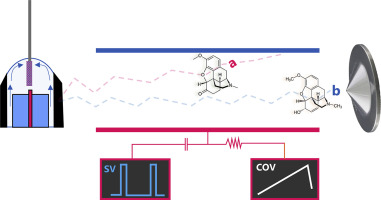当前位置:
X-MOL 学术
›
Anal. Chim. Acta
›
论文详情
Our official English website, www.x-mol.net, welcomes your
feedback! (Note: you will need to create a separate account there.)
Fast quantitation of opioid isomers in human plasma by differential mobility spectrometry/mass spectrometry via SPME/open-port probe sampling interface
Analytica Chimica Acta ( IF 5.7 ) Pub Date : 2017-10-01 , DOI: 10.1016/j.aca.2017.08.023 Chang Liu , Germán Augusto Gómez-Ríos , Bradley B. Schneider , J.C.Yves Le Blanc , Nathaly Reyes-Garcés , Don W. Arnold , Thomas R. Covey , Janusz Pawliszyn
Analytica Chimica Acta ( IF 5.7 ) Pub Date : 2017-10-01 , DOI: 10.1016/j.aca.2017.08.023 Chang Liu , Germán Augusto Gómez-Ríos , Bradley B. Schneider , J.C.Yves Le Blanc , Nathaly Reyes-Garcés , Don W. Arnold , Thomas R. Covey , Janusz Pawliszyn

|
Mass spectrometry (MS) based quantitative approaches typically require a thorough sample clean-up and a decent chromatographic step in order to achieve needed figures of merit. However, in most cases, such processes are not optimal for urgent assessments and high-throughput determinations. The direct coupling of solid phase microextraction (SPME) to MS has shown great potential to shorten the total sample analysis time of complex matrices, as well as to diminish potential matrix effects and instrument contamination. In this study, we demonstrate the use of the open-port probe (OPP) as a direct and robust sampling interface to couple biocompatible-SPME (Bio-SPME) fibres to MS for the rapid quantitation of opioid isomers (i.e. codeine and hydrocodone) in human plasma. In place of chromatography, a differential mobility spectrometry (DMS) device was implemented to provide the essential selectivity required to quantify these constitutional isomers. Taking advantage of the simplified sample preparation process based on Bio-SPME and the fast separation with DMS-MS coupling via OPP, a high-throughput assay (10-15 s per sample) with limits of detection in the sub-ng/mL range was developed. Succinctly, we demonstrated that by tuning adequate ion mobility separation conditions, SPME-OPP-MS can be employed to quantify non-resolved compounds or those otherwise hindered by co-extracted isobaric interferences without further need of coupling to other separation platforms.
中文翻译:

通过 SPME/开放端口探针采样接口,通过差示迁移谱/质谱快速定量人血浆中的阿片类异构体
基于质谱 (MS) 的定量方法通常需要彻底的样品净化和适当的色谱步骤,以实现所需的品质因数。然而,在大多数情况下,此类过程对于紧急评估和高通量测定并不是最佳选择。固相微萃取 (SPME) 与 MS 的直接耦合显示出极大的潜力,可以缩短复杂基质的总样品分析时间,并减少潜在的基质效应和仪器污染。在本研究中,我们展示了使用开放端口探针 (OPP) 作为直接且稳健的采样接口,将生物相容性 SPME (Bio-SPME) 纤维与 MS 耦合,以快速定量阿片类异构体(即可待因和氢可酮)在人血浆中。代替色谱法,实施了差分迁移谱 (DMS) 设备以提供量化这些结构异构体所需的基本选择性。利用基于 Bio-SPME 的简化样品制备过程和通过 OPP 与 DMS-MS 耦合的快速分离,一种高通量测定(每个样品 10-15 秒),检测限在亚 ng/mL 范围内已开发。简而言之,我们证明了通过调整适当的离子淌度分离条件,SPME-OPP-MS 可用于量化未分离的化合物或那些受共提取同量异位素干扰阻碍的化合物,而无需进一步与其他分离平台耦合。利用基于 Bio-SPME 的简化样品制备过程和通过 OPP 与 DMS-MS 耦合的快速分离,一种高通量测定(每个样品 10-15 秒),检测限在亚 ng/mL 范围内已开发。简而言之,我们证明了通过调整适当的离子淌度分离条件,SPME-OPP-MS 可用于量化未分离的化合物或那些受共提取同量异位素干扰阻碍的化合物,而无需进一步与其他分离平台耦合。利用基于 Bio-SPME 的简化样品制备过程和通过 OPP 与 DMS-MS 耦合的快速分离,一种高通量测定(每个样品 10-15 秒),检测限在亚 ng/mL 范围内已开发。简而言之,我们证明了通过调整适当的离子淌度分离条件,SPME-OPP-MS 可用于量化未分离的化合物或那些受共提取同量异位素干扰阻碍的化合物,而无需进一步与其他分离平台耦合。
更新日期:2017-10-01
中文翻译:

通过 SPME/开放端口探针采样接口,通过差示迁移谱/质谱快速定量人血浆中的阿片类异构体
基于质谱 (MS) 的定量方法通常需要彻底的样品净化和适当的色谱步骤,以实现所需的品质因数。然而,在大多数情况下,此类过程对于紧急评估和高通量测定并不是最佳选择。固相微萃取 (SPME) 与 MS 的直接耦合显示出极大的潜力,可以缩短复杂基质的总样品分析时间,并减少潜在的基质效应和仪器污染。在本研究中,我们展示了使用开放端口探针 (OPP) 作为直接且稳健的采样接口,将生物相容性 SPME (Bio-SPME) 纤维与 MS 耦合,以快速定量阿片类异构体(即可待因和氢可酮)在人血浆中。代替色谱法,实施了差分迁移谱 (DMS) 设备以提供量化这些结构异构体所需的基本选择性。利用基于 Bio-SPME 的简化样品制备过程和通过 OPP 与 DMS-MS 耦合的快速分离,一种高通量测定(每个样品 10-15 秒),检测限在亚 ng/mL 范围内已开发。简而言之,我们证明了通过调整适当的离子淌度分离条件,SPME-OPP-MS 可用于量化未分离的化合物或那些受共提取同量异位素干扰阻碍的化合物,而无需进一步与其他分离平台耦合。利用基于 Bio-SPME 的简化样品制备过程和通过 OPP 与 DMS-MS 耦合的快速分离,一种高通量测定(每个样品 10-15 秒),检测限在亚 ng/mL 范围内已开发。简而言之,我们证明了通过调整适当的离子淌度分离条件,SPME-OPP-MS 可用于量化未分离的化合物或那些受共提取同量异位素干扰阻碍的化合物,而无需进一步与其他分离平台耦合。利用基于 Bio-SPME 的简化样品制备过程和通过 OPP 与 DMS-MS 耦合的快速分离,一种高通量测定(每个样品 10-15 秒),检测限在亚 ng/mL 范围内已开发。简而言之,我们证明了通过调整适当的离子淌度分离条件,SPME-OPP-MS 可用于量化未分离的化合物或那些受共提取同量异位素干扰阻碍的化合物,而无需进一步与其他分离平台耦合。











































 京公网安备 11010802027423号
京公网安备 11010802027423号